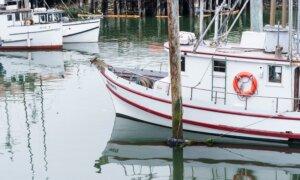Prior regulations on commercial fishing were detrimental to the industry in U.S. territories like American Samoa, the White House has said.
The Trump administration has turned its attention to the commercial fishing industry and issued several executive orders pertaining to easing regulations and supporting the competitiveness of American seafood companies.
The First Order’s Impact
On April 17, President Donald Trump signed the “Unleashing American Commercial Fishing in the Pacific” order, calling on officials to change regulations from the previous administration and ease the burden on commercial fishing around the Pacific Remote Islands Marine National Monument.
The order states that the secretary of commerce will identify the overregulated areas and expand fishing areas to support the work of commercial fishermen.
Under previous orders, American fishing fleets have worked further offshore and been prevented from accessing almost half of the United States’ Exclusive Economic Zone in the Pacific Islands fishing grounds, including 400,000 square miles of marine protected area about 750 miles southwest of Hawaii, surrounding Baker, Howland, and Jarvis islands; Johnston, Wake, and Palmyra atolls; and Kingman Reef.
The administration says that supporting American fishermen will also reduce their need to compete against foreign fleets, which often operate under fewer regulations. According to the Trump administration, previous policies on commercial fishing in U.S. territories like American Samoa were detrimental to the private sector economy in those areas.
The president expressed confidence that other federal environmental protections, including laws and agency management designations, will continue to “protect the area’s natural resources, vulnerable marine species, and unique habitats, such as coral and seamount ecosystems.”
Changes for the Seafood Industry
The “Restoring American Seafood Competitiveness” order, also signed on April 17, outlines the administration’s concern that overregulation has put unfair restrictions on fishermen’s productivity in harvesting American seafood. The order also states that the previous regulations and restrictive catch limits used outdated fisheries data.
The new order seeks to establish an America First Seafood Strategy to boost sales, exports, and long-term growth for the domestic industry.
The presidential order notes that the United States imports almost 90 percent of its seafood, despite controlling more than 4 million square miles of prime fishing grounds. According to the order, this imbalance has created a $20 billion trade imbalance, which is due, at least in part, to the seafood industry bearing some of the heaviest regulations of any sector in the United States.
Applause From Some Fishermen
According to the Southern Shrimp Alliance, the president’s order is good for the American economy in more ways than one.
The group said that Indian shrimp includes products containing antibiotics and veterinary drugs rejected by the Food and Drug Administration in the United States.
American shrimpers follow the world’s strictest regulations, according to the group.
“American shrimpers harvest a premium, sustainable product from our local waters that provides Americans with a healthy protein source while supporting multigenerational shrimping families and their communities,” said John Williams, executive director of the Southern Shrimp Alliance.
Concerns and Criticisms
Sen. Brian Schatz (D-Hawaii) responded to the White House action citing concern about the fragility of marine life.
“At a time when the climate crisis is threatening our fragile ocean ecosystem and costing us lives and livelihoods every year, President Trump’s response is to gut protections for some of our nation’s most important natural resources, including the Pacific Islands Heritage Marine National Monument,” Schatz said.
“We should be protecting the Pacific’s unmatched ecology and biodiversity for future generations—this order does the opposite.”
The nonprofit legal group Earthjustice responded with frustration to the president’s new orders.
Previous Orders
During his first term in office, Trump signed an executive order promoting seafood competitiveness. This followed the Obama administration’s expansion of marine protection in areas like the ones Trump is opening back up.
In addition to increasing access to fishing grounds, the Trump administration has also implemented foreign trade practices, including tariffs, to protect American fishermen.
Original News Source Link – Epoch Times
Running For Office? Conservative Campaign Consulting – Election Day Strategies!


